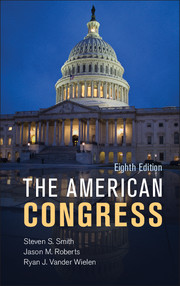Book contents
- Frontmatter
- Contents
- PREFACE
- Acknowledgments
- 1 The Troubled Congress
- 2 Representation and Lawmaking in Congress
- 3 Congressional Elections and Policy Alignments
- 4 Members, Goals, Resources, and Strategies
- 5 Parties and Leaders
- 6 The Standing Committees
- 7 The Rules of the Legislative Game
- 8 The Floor and Voting
- 9 Congress and the President
- 10 Congress and the Courts
- 11 Congress, Lobbyists, and Interest Groups
- 12 Congress and Budget Politics
- Appendix Introduction to the Spatial Theory of Legislating
- Index
- References
2 - Representation and Lawmaking in Congress
The Constitutional and Historical Context
- Frontmatter
- Contents
- PREFACE
- Acknowledgments
- 1 The Troubled Congress
- 2 Representation and Lawmaking in Congress
- 3 Congressional Elections and Policy Alignments
- 4 Members, Goals, Resources, and Strategies
- 5 Parties and Leaders
- 6 The Standing Committees
- 7 The Rules of the Legislative Game
- 8 The Floor and Voting
- 9 Congress and the President
- 10 Congress and the Courts
- 11 Congress, Lobbyists, and Interest Groups
- 12 Congress and Budget Politics
- Appendix Introduction to the Spatial Theory of Legislating
- Index
- References
Summary
In representation and lawmaking, rules matter. The constitution creates both a system of representation and a process for making law through two chambers of Congress and a president. One constitutional rule determines the official constituencies of representatives and senators; another determines how members of Congress are elected and how long they serve. Other constitutional rules outline the elements of the legislative process – generally the House, Senate, and president must agree on legislation before it can become law, unless a two-thirds majority of each chamber can override a presidential veto. More detailed rules about the electoral and legislative processes are left for federal statutes, state laws, and internal rules of the House and Senate.
Although the constitutional rules governing representation and lawmaking have changed in only a few ways since Congress first convened in 1789, other features of congressional politics have changed in many ways. The Constitution says nothing about congressional parties and committees, yet most legislation in the modern Congress is written in committees. Committees are appointed through the parties, and party leaders schedule legislation for consideration on the floor. In this chapter, we describe the basic elements of the representation and lawmaking processes and provide an overview of the development of the key components of the modern legislative process.
- Type
- Chapter
- Information
- The American Congress , pp. 31 - 58Publisher: Cambridge University PressPrint publication year: 2013



